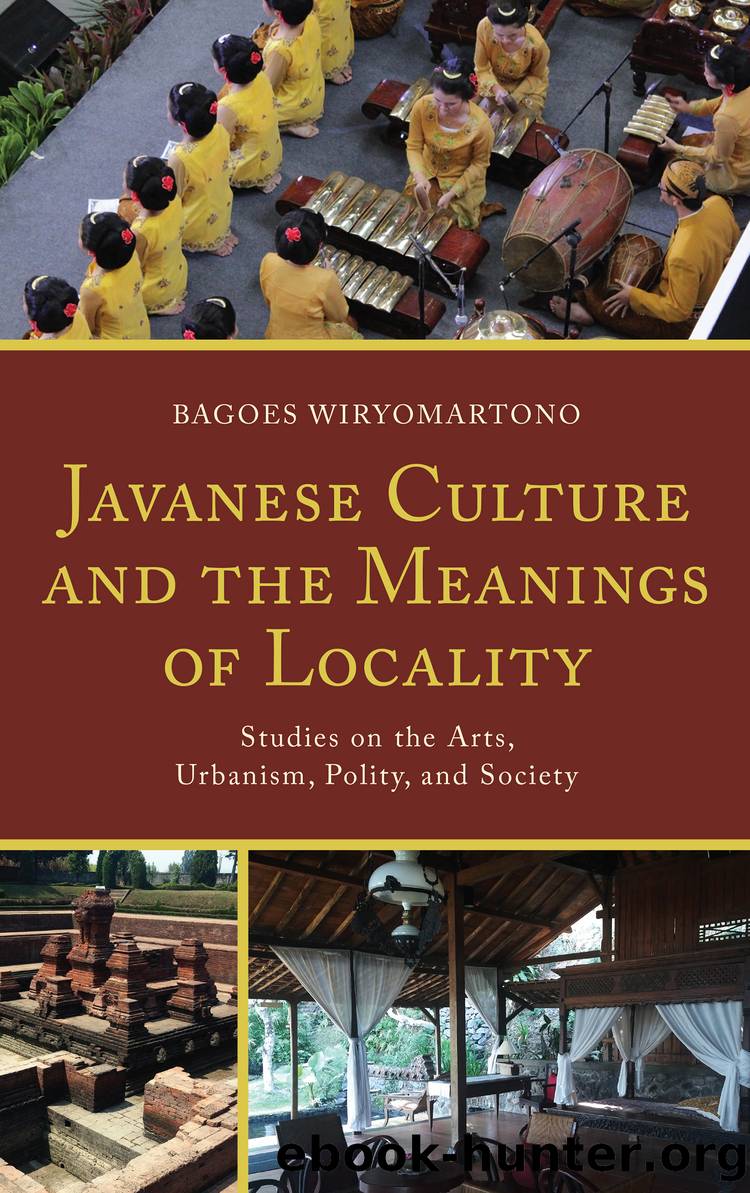Javanese Culture and the Meanings of Locality by Wiryomartono Bagoes;

Author:Wiryomartono, Bagoes; [Wiryomartono, Bagoes]
Language: eng
Format: epub
Publisher: Lexington Books/Fortress Academic
Published: 2016-07-27T00:00:00+00:00
State Ceremony
The palace as a whole does not show something more special than its ritual and ceremonial occasions such as grebeg. The ceremony takes place three times per year: the birthday of the Prophet Muhammad (grebeg maulud), the Ied Fitri (grebeg sawal), and the Ied Adha (grebeg besar). The king and his family will sit in the hall of ponconity in his kedaton, waiting for the commencement of the grebeg. When everything is ready, he moves to the hall of witana (origin, source, heavenly seat) in the siti hinggil zone. It is this zone where the people pay homage to their ruler. During the grebeg ceremony, all halls and buildings are lively, occupied by various activities. Preparing foods for communal meals takes place in the kamadungan zone. It is the zone where the central kitchens are located: gebulen in the west and sekulagen in the east. Both symbolically represent the engendering power of center from birth to death.
The activities in the zone of kamagangan are dominated by youth members of the royal family and royal officers. Colorful costumes and attire are part of their dance and ceremonial performances. They represent the emerging generation of the center that sustains negaraâs glory and splendor. The ritual and ceremony of grebeg gathers all royal components from every zoning group inside and outside the palace wall (beteng). Ceremonially, the conception of grebeg ceremony had been introduced by Sunan Kalijaga and other members of Wali Sanga in various places of Islamic kingdoms such as Demak, Kudus, Surabaya, and Jepara in the sixteenth century. The Demakâs grebeg besar has been commemorated as the inauguration of Raden Patah (1478â1518) as the first sultan of the Demak kingdom in 1503. However, the grand performance of grebeg ceremony was initiated and composed by Sultan Agung Hanyokrokusumo of the Mataram Sultanate (1613â1645); the ceremony and festival of gerebeg had been used by Sultan Agung to integrate the new year of the Islamic calendar system with the Javanese almanac.
Negara in the Indonesian and Javanese context is appropriately understood as a cosmological concept instead of merely a secular notion of political institution. Negara or negari is the source of the cosmic order. It is the destination of paying homage and respect demonstrated with the use of highly courteous manners and language. Urbanity in the Javanese sense is indispensable from the rituals and ceremonies associated with the ruler, court (kraton or istana), and negara. It has nothing to do directly with the concentration of settlement and public service institutions. Most of institutions in the context of negara are for state ritual and ceremonies. The central purpose of negara is to perform a splendor occasion that invokes and revalidates the cosmological unity of dualistic antagonism at various levels and forms of existence. Indeed, the structure of negara is for day-to-day state business, but its entire course of business is to anticipate and celebrate the rebirth of the cosmos called grebeg or keduri.
The history of Javanese rulers from Kahuripanâs Airlangga, Majapahitâs Raden Wijaya, Demakâs Jaka
Download
This site does not store any files on its server. We only index and link to content provided by other sites. Please contact the content providers to delete copyright contents if any and email us, we'll remove relevant links or contents immediately.
The Vikings: Conquering England, France, and Ireland by Wernick Robert(79940)
Ali Pasha, Lion of Ioannina by Eugenia Russell & Eugenia Russell(40158)
The Conquerors (The Winning of America Series Book 3) by Eckert Allan W(37149)
The Vikings: Discoverers of a New World by Wernick Robert(36923)
Cecilia; Or, Memoirs of an Heiress — Volume 1 by Fanny Burney(32438)
Cecilia; Or, Memoirs of an Heiress — Volume 2 by Fanny Burney(31875)
Cecilia; Or, Memoirs of an Heiress — Volume 3 by Fanny Burney(31858)
Empire of the Sikhs by Patwant Singh(22978)
The Secret History by Donna Tartt(18857)
Hans Sturm: A Soldier's Odyssey on the Eastern Front by Gordon Williamson(18489)
Cat's cradle by Kurt Vonnegut(15189)
Pimp by Iceberg Slim(14398)
Sapiens: A Brief History of Humankind by Yuval Noah Harari(14256)
Talking to Strangers by Malcolm Gladwell(13232)
Norse Mythology by Gaiman Neil(13211)
Leonardo da Vinci by Walter Isaacson(13189)
4 3 2 1: A Novel by Paul Auster(12289)
Underground: A Human History of the Worlds Beneath Our Feet by Will Hunt(12027)
The Radium Girls by Kate Moore(11930)
